Gata Kamksy won another interesting “vision” and endgame battle today against Sabino Brunello – which is the topic of today’s posting! Today’s round featured 5 outstanding games – 4 of which were played in the true spirit of competitiveness – where both players were willing and ready to fight for the full point. Only one game was disappointing in this respect. But 4 out of 5 isn’t bad at all!
THE OPENING PHASE
 WELCOME TO THE GRUNFELD DEFENSE!
WELCOME TO THE GRUNFELD DEFENSE!
It is not my intention to discuss the opening of this game as any database or opening book can be consulted. Not that I am uninterested in the opening – the discussion of this phase of the game is just outside the scope of this posting. Based upon the number of diagrams I have included in this posting means that any more would have been quite a bit too much on the eyes! I am much more interested in the early middle game and the endgame phases of this extremely interesting battle.
[Event “52nd It”][Site “Reggio Emilia ITA”][Date “2010.01.03”]
[Round “6”][White “Brunello, S.”][Black “Kamsky, G.”]
[Result “0-1”][ECO “E60”][PlyCount “98”][EventDate “2009.12.28”]
[White Elo “2507”][Black Elo “2695”]
1. d4 Nf6 2. c4 g6 3. g3 Bg7 4. Bg2 O-O 5. Nf3 c6 6. Nc3 d5 7. cxd5 cxd5 8. Ne5
e6 9. O-O Nfd7 10. f4 Nc6
(Board 1 : A well known position to fans of Anatoly Karpov. These closed variations of the Grunfeld tend to be rather drawish – but not today! Sabino Brunello deserves full credit for going “all in” against Kamsky in this highly instructive game from round 6 of Reggio Emilia 2009/2010. Even if he was “outplayed” into it!)
11. Be3 Nb6 12. Bf2 Ne7 13. a4 a5 14. Rc1 Bd7 15. Nxd7 Qxd7
(Board 2: Kamsky has developed his forces much more efficiently during the opening negotiations of this game. I would also rather have the “Knight pair” in such closed positions as well. Compared to White’s Bishop pair I see a very bright future for Kamsky’s cavalry – unless of course the position becomes somewhat murky.)
16. Qb3 Nc4 17. Rfd1 Nf5 18. Ne4 Rac8 19. Nc5 Qe7 20. e3 b6
(The “big moment” of this game! In true “Karpovian style” Gata has gripped the squares very nicely with his pieces – in particular notice how both Knight co-ordinate nicely now. All of Kamsky’s pieces are posted really well – as opposed to their counter parts in the White army. Sabino really has no choice here – he actually HAS to go all in with the exchange sacrifice or else he is just losing material and with it, more than likely in the long run, the game. Get ready to hold onto your seats because you are in for the chess ride of your life now! This is the starting point in the game where I would really like to begin taking a much deeper look at what is actually going on.)
GATA KAMSKY

SABINO BRUNELLO
Sabino tries to muddy the waters!
21. Rxc4
This is forced and I suppose that Sabino was thinking along these lines when he took this action – If I do not do this exchange sacrifice then I will just be squeezed to death by Kamsky’s better positioned pieces/troops. If I do not do the exchange sac then I will be losing material and in the long run the game.
If I do the exchange sac I will have a very nicely posted Knight on c5, I will eliminate one of Kamsky’s most active pieces – the annoying Knight on c4, I will be able to open up the position by moving the central pawns and uncovering an attack against the Queenside – my Bishops will command an open board and I will have a passed pawn on the Queenside as well. I will get some pawns while countering Kamksy – and his Bishop on g7* is out of play once I block off the a1-h8 diagonal with pawns.
ON THE FLIP SIDE : Kamsky will get open lines for his Rooks, His King is much safer and he will be able to activate his pieces much more quickly than his opponent – Brunello – because Sabino’s plan will take quite a while to carry out. In the process of trying to open up the position for his, Sabino Brunello’s, Bishop Pair Kamsky will be able to create additional weaknesses in the enemy position. Two of these weaknesses are going to be the long white a8 – h1 diagonal and the not so well defended 1st rank.
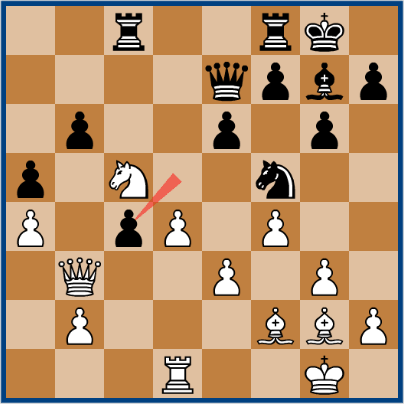
21. …dxc4
“In for a penny, in for a pound” – As the Brits would put it!

22. Qxb6
Quite the struggle now!
*Please note that BOTH dark squared Bishops are rather poorly placed! Black’s on g7 will not strike down anything along it’s diagonal while the White dark squared Bishop is a big pawn!

22. …Rb8
Kamsky now activates his Rook along the b-file. This will be a very important – his Rooks need to gain access to the weakened back rank. This is actually an extremely important event during this game – as the effects will be rather long term.

23. Qxa5
Brunello creates the passed a-pawn, something to try and distract Kamsky with. It doesn’t quite work out that way in the game though.

23. …Rxb2 24. Bf1
The White pieces still seem awkwardly placed… but Sabino has to activate them and the only way to do this is to start using the diagonals on the Queen-side. However this will create weaknesses as the King will now have diagonals that lead to him open up as well. Kamsky will still be able to use the diagonals – he has his Queen and his dark squared “Indian” Bishop* – which needs to be activated ASAP.
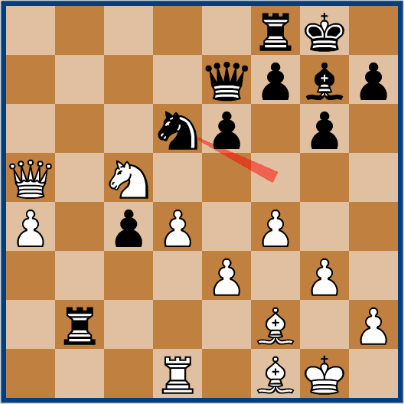
24. …Nd6
Black moves the Knight to hold onto the c4-pawn while further enhancing his b-file options. The e4-square is now contested as well.

25. Qc3
This move allows Sabino to attack the c4-pawn a second time while clearing the way for the a-pawn to run down the a-file. The “Loose” Rook is also attacked.

25. …Rfb8
Kamsky now has a road down which his rooks may travel – job one will be to control the b-file and then to exchange off the lone White Rook thus weakening the back rank. Remember – if you can double your Rooks on a file or Rank then you should do so. The doubled Rooks are extremely powerful as they can protect each other.

26. e4
Several ideas behind this move – drive away the Black Knight on d6 and to shut down the a1-h8 diagonal. Kamsky already has an idea about how to reactivate his dark squared Bishop. Kamsky is looking at all of his options and while some of them are subtle Kamsky does an excellent job of making them readily apparent.
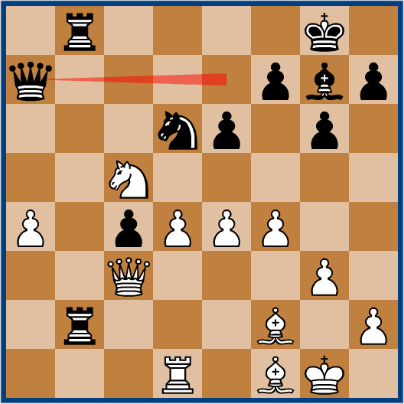
26. …Qa7
An interesting idea – putting the Queen into a pin to create counter threats! If Sabino isn’t careful he could lose his Bishop on f2 and wind up getting checkmated in short order. The Black Queen also exerts power along all lines which she looks down on that side of the board.

27. e5
Another charming feature of Kamsky’s last move is that it anticipated this e5 push. The dark Squared Bishop is now going to be activated along the f8-a3 diagonal… despite Sabino’s best efforts to sideline this piece.

27. …Nf5
This Knight can dance back on over from f5 to e7 and will be able to reinforce control over the d5 square.
Sabino would not want to play the g4 pawn push – attacking the Knight on f5 – as this will further weaken the White King-side. However this may have been a better strategy as the long term prospects on the Queen-side may not be enough to give serious counter chances. Also in light of the fact that the diagonals leading to the White King will become extremely drafty in any event.
KAMSKY

BRUNELLO
28. Bxc4
White’s trumps: Activated pieces and a passed white a-pawn. It is also interesting to note that the material count is event – two pawns and a Knight for a Rook.
White’s problems: Weak back rank issues and diagonals that are opening up – for the Black Pieces. Fixed pawns and drafty squares around the White King – a Monarch who will find no truly safe haven. I would call these organic weaknesses.
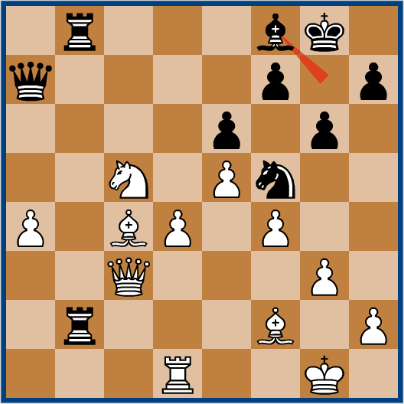 28. …Bf8
28. …Bf8
Rerouting the Bishop along another diagonal – seeking more gainful employment else where on the chess board.

29. Nd3
While this move looks to save the extremely useful Knight it unfortunately helps Kamsky to invade down the b-file and to weaken the back rank by exchanging off the lone White Rook. This Knight was the piece that was holding the White Position together – now that it has been threatened and has retreated the position begins to alter significantly.

29. …Rb1
No need for commentary – Gata Kamsky is just following his plan by playing the “only” move that makes sense in the position.

30. Rxb1

30. …Rxb1+
Now the 1st Rank is weakened. What is Brunello to do? The position around his King is drafty and his pieces do not co-ordinate effectively because of the pawn structure – the very same pawn structure that is now in the way of his pieces and that does not protect squares around the White Monarch.

31. Kg2 Qa8+ 32. d5 Ne7
Now the organic weaknesses in Brenello’s position are apparent. The weak long diagonal and the weak back rank – all lines lead to a weakened area around the White King. The attempt at blocking off the diagonal with the pawn push fails because of the additional attacker who jumps into the fray – our good Knight who hops from f5 to e7.

33. Nc5 Nxd5 34. Qf3 Bxc5 35. Bxc5 Qc6 36. Bxd5
Another interesting moment in the game. Should Kamsky recapture the Bishop on c5 or the one on d5? This is critical – which capture offers Kamsky the greatest chance of victory in this game. To capture the White squared Bishop means that the a-pawn will fall quite quickly – but leaving the dark squared Bishop on means that the drafty dark squares around the Black Monarch may become targeted.
KAMSKY

BRUNELLO
36. …Qxc5
Now it is time to take stock:
White still has his passed a-pawn but is down an exchange and has a very vulnerable and weak King.
Kamsky has two pieces that can combine nicely against the White King – his Rook and Queen. The passed a-pawn is going no where and the Black King is the much safer of the two Monarchs. Kamsky can create threats easily with his Queen and Rook as the Queen can opperate along diagonals and Ranks. Brunello’s Queen is tied to defense – of the Bishop and of the King. This fact means that Kamsky can over work these pieces and create unstoppable threats against the vulnerable White King.
KAMSKY
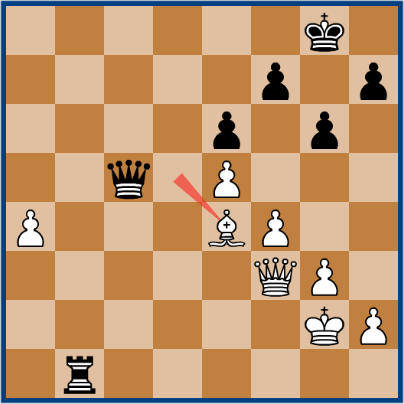
BRUNELLO
37. Be4

37. …Qg1+
That weak back rank – it never went away as an issue during this game! It was there for the long term.

38. Kh3
As they say in the Yugoslav publication “CHESS INFORMANT”, BOX! This means “only move” – and this is usually never a good sign if we are forced to play such moves during our games. If our options are running thin then we are losing the game – remember Chess is about control of the squares or the space if you like – and if you have to play only moves then you have lost control on the board.

38. …Rb2
Threatening a not so subtle checkmate! For example 39. a5?? Qxh2 + 40. Kg4 Qh5 + +

39. Qh1
BOX!

Let us Keep the Queens on – as well as the pressure against the White Monarch!
39. …Qf2
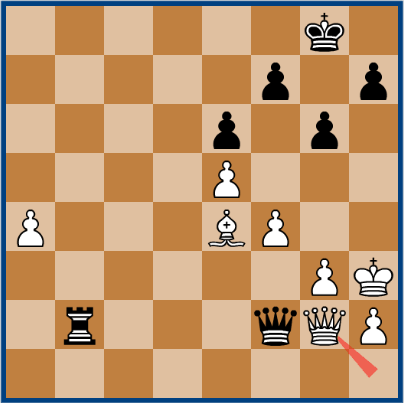
40. Qg2
Hoping to exchange off the White Queen and then to post the Bishop on c6 thus protecting the far passed pawn. This would still be a somewhat rather grim game but would offer greater cheapo chances.

40. …Qd4

41. Qf3
BOX!

41. …Qxa4
That a4-pawn will not be distracting Kamsky from his objective now – going after the White King.

42. Qd3
White is running short of squares down which to run with his pieces. That sort of thing will happen when you are always on the defensive and you have a material deficit.

42. …Qa5
Protecting the d8 square and getting ready to swing the Rook to d2 thus centralizing the tower. Centralization is always desirable – we should aim for such control in our own games.

43. Bc6
Interesting piece the Bishop. When trying to deliver a checkmate with Queen and Bishop it is usually the case that this is a somewhat clumsy partnership as the two pieces both operate along the diagonals. They end up tripping over each other in that they have a move in common with each other. Whereas having a Queen and Knight is typically – in most positions – a more desirable pairing allowing for easier checkmating possibilities.
Rooks can be and are sometimes rather clumsy pieces themselves but are an advantage in endgames when battling against our opponent’s Bishop. Very often last rites are to be delivered to the side with the Bishop – with pawns being even. As always we chess players have to watch out for those devilish details as positions do differ in their important features.
Because of the pawn structures in this game the Queen and Rook are far superior to the Queen and Bishop. It is just a matter of time before the White King is executed. Already here Kamsky begins to think about using the Rook and the Queen to continue controlling key Ranks and files but to also allow the Queen to a very important diagonal. One which Sabino Brunello will be unable to defend forever.

43. …Rd2
The Rook is now officially centralized!

44. Qc4
I am sure that Sabino was hoping that Kamsky would allow some miracle save – perhaps his Queen and Bishop gaining access to the f7 square and allowing a cheapo checkmate. This is no more realistic than hoping for a meteor to come crashing down on Gata’s head!

44. …Qb6
Controlling the d8 square still and again thinking about the f2 or g1 squares.

45. Bg2??
Clumsy piece that Bishop! With the weakened King and nothing to attack this Bishop is just shifting back and forth dreaming of gainful employment. Notice that both the Black Queen and the Black Rook are moving along the dark squares now! The color of the squares are very important!!

45. …Qb2
The b2-square was also being eyed up by the Black Queen! Now the Bishop is pinned to the h2 pawn and thus tied down for good.

46. Qe4
Nothing to be done but to wait for the inevitable! Passive defense will always lose against an inventive attacker who pays attention to the squares.

46. …h5
Now the h-pawn joins in on the attack! By controlling the g4 square this pawn ties down the White King and his loyal pawn subjects even further. Less and less options for Sabino Brunello’s pieces and more control for Gata Kamsky.

47. Qa8+
Spite check time – equivalent to throwing in the towel.

47. …Kg7
Safe and sound.

48. Qe4
Back again to whence the Queen came from.

48. …Re2
Now it is ok for the Rook to move onto the White Squares! The Rook attacks the White Queen driving her away from defense of the f5 square – which is a place the Black Queen would very much like to visit. Also notice that the Bishop on g2 is still unable to move away as then Rxh2 will win the day for Kamsky.

49. Qa8

49. …Qc2 Brunello Resigned. 0-1
The threat of …Qf5 convinced Sabino Brunello to capitulate. Attempting to avoid this threat only accelerates defeat but does not greatly delay the inevitable. Both Rook and Queen control the square e4 thus allowing the Black Queen to jump up to f5 with devastating effects.
Two example lines might run
1.) 49. Qa8 Qc2 50. g4 Re3 + 51. Bf3 Qf2 wins it all.
2.) 49. Qa8 Qc2 50. Qc6 Qf5+ 51. Kh4 Qg4 + +
I hope you all have enjoyed this game at least half as much as I have! – Coach Sean Tobin.
























































Wijk aan Zee: Quite the event… so far.
January 20, 2010With Shirov going 4 for 4 right out of the starting gate this has become a very interesting horse race – with plenty of contenders chasing after Shirov. It is still too early yet to say who will win this years’ edition of Wijk aan Zee. Much to much early to speculate upon what kind of chess tournament Shirov will have for this year’s edition as he has yet to play Carlsen, Anand, Kramnik and Ivanchuk – opponents who are capable of winning or losing to the latvian now Spanish firebrand.
I will provide some commentary upon games from this event in upcoming postings – as there are already many interesting games that have been played as of round four. Shirov will have to really focus now and control his nerves if he is to attempt the amazing feat matching Karpov’s phenomenal accomplishment at Linares 1994. Let us all cheer on Shirov’s brand of chess – fighting chess – and keep our fingers crossed for more of it in upcoming rounds.
– Sean Tobin.
Posted in CHESS COMMENTARY, CHESS TOURNAMENTS | Leave a Comment »